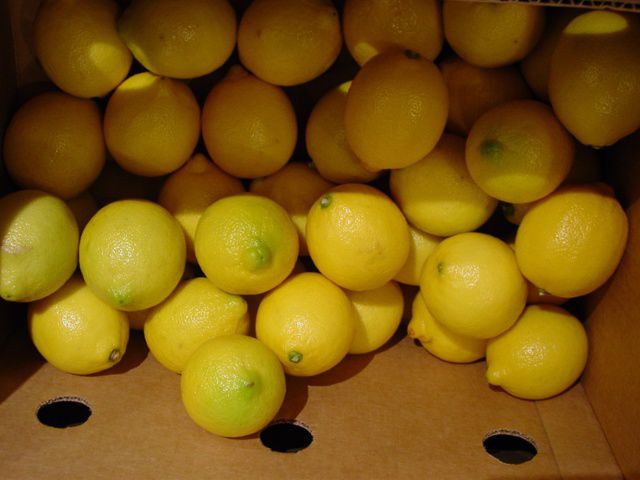Importing Argentine Lemons Put Our Markets at Risk
Published
8/18/2016
By Ana Kennedy Otto, Arizona Farm Bureau Government Relations Manager: The federal government is eyeing citrus from south of the border.
The Animal and Plant Health Inspection Service (APHIS) and United States Department of Agriculture’s (USDA) recently proposed the importation of Argentine lemons, an effort Arizona Farm Bureau and Arizona’s citrus industry opposes because of the increased risk of pests and diseases from that region and the resulting economic harm to U.S. lemon growers and local economies that depend on them.
As a result, Arizona Farm Bureau recently filed a comment with APHIS and the USDA to keep Argentina lemons from entering our country.

A robust domestic lemon industry is an important economic component for the communities where lemons are grown. In Yuma County,
The domestic production of U.S. lemons occurs primarily in California and Arizona. As noted in the proposed rule itself, California makes up 92% of the value of production and Arizona 8 % respectively. A robust domestic lemon industry is an important economic component for the communities where lemons are grown. In Yuma County,
Representing farmers and ranchers from all across the state, including citrus producers, Arizona Farm Bureau highlighted how important the citrus industry is to our state. Citrus has played a prominent role in Arizona as one of the 5 “C’s” on which the state’s economy was originally built. The citrus industry, which, includes lemons, still contributes more than $63 million to the state, according to the USDA. Today the primary commercial citrus growing areas are located in Yuma and Maricopa Counties with the majority of production taking place in Yuma County.
Pests and Disease
The APHIS rule itself notes nine pests of quarantine significance present in Argentina that could follow the pathway for lemons from northwest Argentina to the continental U.S. APHIS prepared a pest risk assessment (PRA) that “derives plant pest risk potential for pest by estimating the likelihood of introduction of each pest into the continental U.S. through the importation of lemons from northwest Argentina.” Of the nine
The B.
Although the proposed rules lay out a number of requirements to be taken at the place of production, packing
Economic Analysis
Arizona Farm Bureau and the state’s citrus industry also has concerns regarding the economic analysis conducted by APHIS, which shows the welfare gains for consumers would outweigh producers’ losses by $2 million to $3 million. Although there is a welfare gain, it is relatively small. Additionally, the analysis concludes producers’ losses would range from $18 million to $24 million. Conversely, a reported Arizona State University study commissioned by the U.S. lemon industry indicates much higher losses ranging from $183 million to $261 million.
Producer losses under the APHIS economic analysis
Another area of concern regarding the economic analysis is whether the costs of APHIS’s work with the national plant protection organization of Argentina and onsite monitoring were included. These costs are not trivial and would ultimately be borne by the U.S. taxpayer. The available supporting documents do not indicate whether these costs were considered in the economic analysis and reflected in the net benefits. The economic analysis also does not quantify the risk of pest and disease entering the U.S. with Argentine lemons. U.S. producers would undoubtedly face a number of increased costs for pest abatement and/or treatment, quarantine regulations and restrictions, loss of productivity, etc.
“Furthermore, the importation of Argentine citrus also impedes the expansion of domestic lemon production,” explains Yuma County Farm Bureau President Mark Loghry, co-owner of Sunset Nursery, Inc., a 4th generation, family-owned wholesale citrus nursery. “A local citrus stock nursery has already had contracts for lemon trees
Timing of Imported Lemons
The proposal indicates Argentine lemons would be exported to the U.S. from April through August to reduce the risk of Medfly infestation and is a “period that coincides roughly with the months in which U.S. lemon exports are declining and imports are increasing.” In
“The U.S. citrus industry is already dealing with the crop destroying citrus greening disease carried by Asian citrus psyllid,” said Arizona Farm Bureau President Kevin Rogers. “This is not the time to introduce the potential risk of new pests and diseases. The economic analysis of the proposal fails to account for all the costs that would be incurred to consumers and local economies where lemons are grown. The timing of the imports coincides with both Arizona and California harvest times and would depress lemon prices which would not be easily absorbed by lemon growers and put some out of business. For these reasons we do not support the proposal to import lemons from Argentina and urge APHIS to withdraw the rule.”